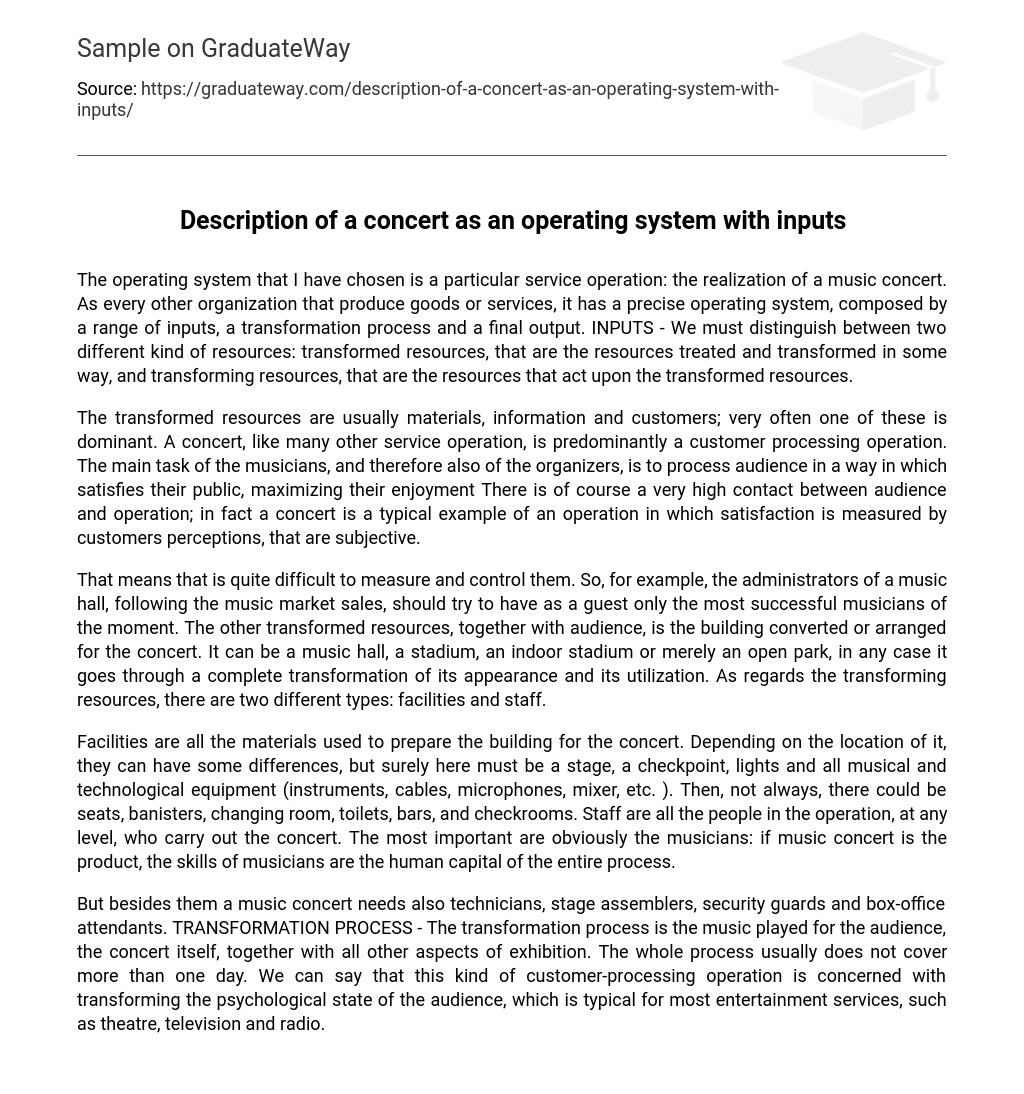The operating system that I have chosen is a particular service operation: the realization of a music concert. As every other organization that produce goods or services, it has a precise operating system, composed by a range of inputs, a transformation process and a final output. INPUTS – We must distinguish between two different kind of resources: transformed resources, that are the resources treated and transformed in some way, and transforming resources, that are the resources that act upon the transformed resources.
The transformed resources are usually materials, information and customers; very often one of these is dominant. A concert, like many other service operation, is predominantly a customer processing operation. The main task of the musicians, and therefore also of the organizers, is to process audience in a way in which satisfies their public, maximizing their enjoyment There is of course a very high contact between audience and operation; in fact a concert is a typical example of an operation in which satisfaction is measured by customers perceptions, that are subjective.
That means that is quite difficult to measure and control them. So, for example, the administrators of a music hall, following the music market sales, should try to have as a guest only the most successful musicians of the moment. The other transformed resources, together with audience, is the building converted or arranged for the concert. It can be a music hall, a stadium, an indoor stadium or merely an open park, in any case it goes through a complete transformation of its appearance and its utilization. As regards the transforming resources, there are two different types: facilities and staff.
Facilities are all the materials used to prepare the building for the concert. Depending on the location of it, they can have some differences, but surely here must be a stage, a checkpoint, lights and all musical and technological equipment (instruments, cables, microphones, mixer, etc. ). Then, not always, there could be seats, banisters, changing room, toilets, bars, and checkrooms. Staff are all the people in the operation, at any level, who carry out the concert. The most important are obviously the musicians: if music concert is the product, the skills of musicians are the human capital of the entire process.
But besides them a music concert needs also technicians, stage assemblers, security guards and box-office attendants. TRANSFORMATION PROCESS – The transformation process is the music played for the audience, the concert itself, together with all other aspects of exhibition. The whole process usually does not cover more than one day. We can say that this kind of customer-processing operation is concerned with transforming the psychological state of the audience, which is typical for most entertainment services, such as theatre, television and radio.
OUTPUTS – The output of a music concert is first of all the entertained audience, but we cannot forget to mention the importance of having guaranteed security for all the people inside the building. The general heartsickness of these outputs are the same that distinguish outputs of every organization that produces services from outputs of organization that produce goods: not tangible, non-storable, untranslatable and simultaneous (in other words produced and consumed at the same time).
Just the exact opposite of a normal good. Another difference between goods and services, as said before, is that the quality of goods is reasonably evident, it is measurable. But in a concert it is a little bit more complicate. The customer is inside the operation, he judges not only the outcome of the service (the music), but also the aspects of the way in which it was produced (all the rest of the scene). The input-transformation-output model can also be used within operations.
All operations are made up for several units or departments, witch themselves act as smaller versions of the whole operation, with their own resources and their own outputs. So any operation can be considered as a hierarchy of operations. This is more true for greater manufacturing operation than the ours, but also inside a music concert we can distinguish some different micro operations, as stage operations, location for audience, performance realization.





